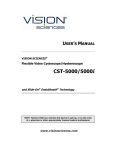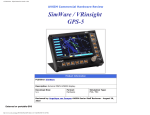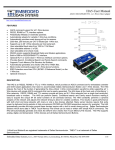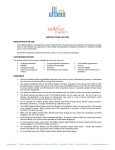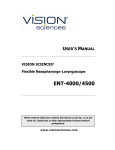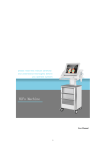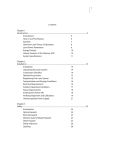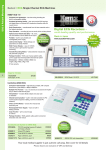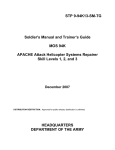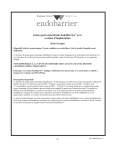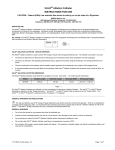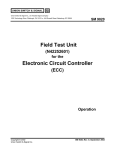Download Instructions for Use
Transcript
Ulthera® System Instructions for Use Featuring DeepSEE® Technology for Ultherapy® THIS PAGE INTENTIONALLY LEFT BLANK Page 2 Ulthera, Inc. March 2015 Published in the USA CAUTION: UNITED STATES FEDERAL LAW RESTRICTS THIS DEVICE TO SALE BY OR ON THE ORDER OF A PHYSICIAN. THE ULTHERA® SYSTEM IS INTENDED FOR USE ONLY BY PROPERLY TRAINED PHYSICIANS AND PROPERLY TRAINED PERSONS UNDER THE SUPERVISION OF SUCH A TRAINED PHYSICIAN (HENCEFORTH “THE USER”). PRIOR TO OPERATING THE SYSTEM, THE USER MUST THOROUGHLY READ AND UNDERSTAND THIS MANUAL. IMPROPER USE OF THE SYSTEM MAY CAUSE PERSONAL INJURY AND/OR DAMAGE TO THE SYSTEM THAT MAY INVALIDATE THE WARRANTY AGREEMENT. THE ULTHERA® SYSTEM IS INTENDED FOR LIFTING AND SCULPTING OF SKIN BY WAY OF DEPOSITION OF MICRO-FOCUSED ULTRASOUND ENERGY AT DEPTHS BETWEEN 1.5 AND 4.5MM BENEATH THE SKIN. DEPOSITION OF ENERGY RESULTS IN A CHANGE TO THE PHYSIOLOGY RESULTING IN STIMULATION OF NEW COLLAGEN AND ELASTIN AS PART OF THE HEALING PROCESS. THE ULTHERA TRANSDUCERS CAN BE REUSED UNTIL 2400 LINES OF TREATMENT IS PROVIDED. THE USEFUL LIFE OF THE ULTHERA CONTROL UNIT IS 4 YEARS AND HANDPIECE 5 YEARS BASED ON THE USEFUL LIFE OF THE COMPONENTS AND TESTING. THIS STATEMENT DOES NOT IMPLY A WARRNTY COVERING THAT PERIOD OF TIME. PLEASE SEE WARRANTY INFORMATION IN YOUR PURCHASE TERMS AND CONDITIONS. Ulthera, Inc. Page 3 © 2015, Ulthera, Inc. All Rights Reserved. The marks ULTHERA, ULTHERAPY, and DEEPSEE are registered in the U.S. and/or certain foreign countries to Ulthera, Inc. (henceforth "Ulthera"). The marks SEE THE POWER OF SOUND, SEE THE BEAUTY OF SOUND, ULTHERA AMPLIFY, ULTHERAPY AMPLIFY, and AMPLIFY are trademarks of Ulthera. This manual may not be copied, translated, or reproduced in whole or in part without the express written consent of Ulthera. Various features of the Ulthera® System are covered by U.S. Patents 6,049,159, 7,758,524, 8,366,622, 8,444,562, 8,506,486, 8,535,228, 8,641,622, 8,690,778, 8,690,779, 8,690,780, and 8,915,853 and contemplated features may be covered by one or more of the following U.S. Patents: 5,820,564; 6,036,646; 6,050,943; 6,120,452; 6,213,948; 6,440,071; 6,500,121; 6,540,679; 7,142,905; 7,229,411; 7,393,325; 7,491,171; 7,530,958; 7,571,336; 7,615,016; 7,824,348; 7,914,453; 8,057,389; 8,066,641; 8,166,332; 8,128,618; 8,133,180; 8,235,909; 8,282,554; 8,333,700; 8,409,097; 8,460,193; 8,480,585; 8,523,775; 8,636,665; 8,663,112; 8,672,848; 8,708,935; 8,715,186; 8,857,438; 8,915,870; 8,915,854; and 8,920,324. More than 100 other U.S. and International patents to which Ulthera has rights are issued, published, or pending. Page 4 Ulthera, Inc. THIS PAGE INTENTIONALLY LEFT BLANK Ulthera, Inc. Page 5 Table of Contents 1. 2. 3. 4. 5. 6. Introduction to Manual ......................................................................................... 8 1.1. Purpose .................................................................................................................. 8 1.2. Conventions .......................................................................................................... 8 Medical Safety ....................................................................................................... 9 2.1. Intended Use ......................................................................................................... 9 2.2. Indications for Use ................................................................................................ 9 2.3. Contraindications ................................................................................................. 9 2.4. Precautions ............................................................................................................ 9 2.5. Patient Safety ...................................................................................................... 10 2.6. Potential Side Effects .......................................................................................... 11 2.7. Complaints and Adverse Events ...................................................................... 11 System Overview .................................................................................................. 12 3.1. System Description ............................................................................................. 12 3.2. System Components and Features.................................................................. 12 System Safety........................................................................................................ 18 4.1. Electrical and Fire Safety ................................................................................... 18 4.2. Equipment Use and Care .................................................................................. 19 4.3. Ergonomic Safety ............................................................................................... 20 4.4. Medical Ultrasound Safety ................................................................................ 20 4.5. Electromagnetic Compatibility and Immunity ............................................... 20 4.6. Disposal ................................................................................................................ 21 4.7. Safety Symbols .................................................................................................... 22 Setting Up for First-Time Use ................................................................................ 24 5.1. Unpacking ........................................................................................................... 24 5.2. Physical Environment ......................................................................................... 24 5.3. Electrical Requirements ..................................................................................... 25 5.4. Connecting Components ................................................................................. 25 Treatment Guidelines .......................................................................................... 27 6.1. 7. System Operation ................................................................................................ 37 7.1. Page 6 Preset Guidelines and Energy Levels ............................................................... 27 Ulthera System Access Key ............................................................................... 37 Ulthera, Inc. 7.2. User Interface ...................................................................................................... 37 7.3. Operating Instructions ........................................................................................ 43 7.4. Adjunctive Functions.......................................................................................... 50 7.5. Troubleshooting .................................................................................................. 54 8. System Messages ................................................................................................. 56 9. Cleaning and Care ............................................................................................. 60 9.1. Cleaning the Transducer and Handpiece ..................................................... 60 9.2. General Care of the System ............................................................................. 60 10. Reorder Information ............................................................................................ 62 11. Safety Standards and Regulatory Classifications ........................................... 63 Ulthera, Inc. Page 7 1. Introduction to Manual 1.1. Purpose This Instructions for Use manual provides a description of the System components, its controls and displays, instructions for its operation, and other equipment information important to the user. Warning: Do NOT operate the Ulthera System before reading this manual thoroughly. In addition to this manual, additional clinical training may be available by the Company or your local distributor. For more information on training available, please contact your local representative. 1.2. Conventions Note: Notes designate information of special interest. Caution: Cautions alert the user to precautionary steps necessary to properly operate the system. Failure to observe these cautions may void the warranty. Warning: Warnings alert the user to information that is of the highest importance and vital to the safety of the patient and user. All procedures are broken down by numbered steps. Steps must be completed in the sequence they are presented. Bulleted lists indicate general information about a particular function or procedure. They do not imply a sequential procedure. Control names are spelled as they are on the system, and they appear in Bold text. Page 8 Ulthera, Inc. 2. Medical Safety 2.1. Intended Use The Ulthera® System is intended for lifting and sculpting of skin by way of the deposition of micro-focused ultrasound energy at depths between 1.5 mm and 4.5 mm beneath the skin. Deposition of ultrasound energy results in a change to the physiology, resulting in stimulation of new collagen and elastin as part of the healing process. The Ulthera System is also intended for the treatment of Axillary Hyperhidrosis by way of the deposition of the micro-focused ultrasound energy at depths between 3.0 mm and 4.5 mm beneath the skin, targeting the depth at which sweat glands reside. Coagulation takes place in tissue located at the dermal hypodermal interface where the sweat glands reside using a surface contact applicator. Sweat glands are destroyed during coagulation. 2.2. Indications for Use The Ulthera System is indicated for: • • 2.3. Use for non-invasive dermatological sculpting and lifting of the dermis o Upper Face o Lower Face o Neck o Décolleté Non-invasive treatment of Axillary Hyperhidrosis Contraindications The Ulthera System is contraindicated for use in patients with: • • • 2.4. Open wounds or lesions on the face and/or neck Severe or cystic acne on the face and/or neck Pacemakers and electronic device implants in treated area Precautions When not in use by trained personnel, the Ulthera System Access Key should be removed from the system to help prevent unauthorized use. Keep the Ulthera System Access Key in a designated place accessible only to authorized and trained personnel. Ulthera, Inc. Page 9 The Ulthera System has not been evaluated for use over various materials. Therefore, treatment is not recommended directly over those areas with any of the following: • • • • • Mechanical implants Dermal fillers Implanted electrical devices in the face and/or neck Metal stents in the area of treatment (e.g. face, neck, décolleté (center of chest)) Breast implants Treatment energy is not recommended for use directly on an existing keloid. The Ulthera System has not been evaluated for use in patients on an anticoagulant treatment plan. It is recommended that the following areas should be avoided during treatment: • • • Thyroid gland, thyroid cartilage and trachea Major vessels Breast tissue or breast implant The Ulthera System has not been evaluated for use in the following patient populations: • • • 2.5. Pregnant or breast-feeding women Children Those with the following disease states: o A hemorrhagic disorder or hemostatic dysfunction o An active systemic or local skin disease that may alter wound healing o Herpes simplex o Autoimmune disease o Diabetes o Epilepsy o Bell’s palsy Patient Safety Warning: Ulthera should not be used on a patient’s eyes or in a location or technique where ultrasound energy can reach the eye. Warning: Use this system only if you are trained and qualified to do so. Warning: If any problems occur during system operation, take immediate action(s): lift the transducer off the patient’s skin, press the See pushbutton Page 10 Ulthera, Inc. on the handle to discontinue the treatment in progress, and/or press the red emergency Stop button to completely halt system operation. 2.6. Potential Side Effects Side effects reported in the clinical evaluation of the Ulthera System were mild and transient in nature. These were limited to: • • • • • • 2.7. Erythema (redness): The treated area may exhibit erythema immediately following treatment. This typically resolves within a few hours of treatment. Edema (swelling): The treated area may exhibit mild edema following treatment. This typically resolves within a few days of treatment. Pain: Momentary discomfort may be experienced during the procedure while energy is being deposited. Post-procedure discomfort or tenderness to the touch is also possible. Bruising: Mild bruising, which is caused by damage to soft tissue blood vessels, may occur occasionally and typically resolves within a few days of treatment. Nerve effects: o Transient local muscle weakness may result after treatment due to inflammation of a motor nerve. o Transient numbness may result after treatment due to inflammation of a sensory nerve. o Transient pain, paresthesia and/or tingling may be experienced. o No permanent injuries to facial nerves have been reported. Scarring: The possibility for scar formation (which may respond to medical care) may exist if incorrect treatment technique is used. Complaints and Adverse Events No serious adverse events were observed during the clinical study evaluation of the Ulthera System. Ulthera follows MDR (Medical Device Reporting) rules for handling complaints and adverse events. Should an adverse event be suspected or reported, contact Ulthera, Inc. at the number on the back page of this document. For those outside the U.S., contact your local Ulthera representative. Ulthera, Inc. Page 11 3. System Overview 3.1. System Description The Ulthera System integrates the capabilities of ultrasound imaging with those of ultrasound therapy. The imaging feature allows the user to visualize the skin and sub-dermal regions of interest before treatment. It also allows the user to assure proper skin contact in order to deliver the energy at desired depths. The therapy feature directs acoustic waves to the treatment area. This acoustic energy heats tissue as a result of frictional losses during energy absorption, producing discrete points of coagulation. 3.2. System Components and Features The Ulthera System consists of three primary components: the control unit with integrated touchscreen, the handpiece with cable, and interchangeable transducers (see Figure 3.1). Figure 3.1 Main components of the Ulthera® System: control unit (top), handpiece (bottom right), and image/treat transducer (bottom left) that inserts into the handpiece receptacle Page 12 Ulthera, Inc. 3.2.1. Control Unit The control unit is the tabletop information center for the Ulthera System. It houses the touchscreen monitor and Graphical User Interface (GUI) that allows the user to interact with the device. This screen sets and displays the operating conditions, including equipment activation status, treatment parameters, system messages and prompts, and ultrasound images. Figure 3.2 illustrates the physical features of the control unit, such as the various connector ports and power controls. Figure 3.2 Control Unit Front View (left) and Rear View (right) See Table 3.1 for a description of the controls and connector ports of the control unit. Table 3.1 Control Unit Connector Ports and Controls (See Figure 3.2) ITEM Handpiece Connector DESCRIPTION 1 Receptacle Socket for plugging in handpiece cable 2 USB Ports (two) For optional USB removable storage device 3 Emergency Stop Halts system operation if pressed • Momentarily press to turn system ON 4 On / Off Button • Momentarily press to turn system OFF • Press and hold to force system shutdown 5 Rear Panel USB port For Ulthera System Access Key 6 Main Power Switch Supplies power to system. Leave ON (symbol “|” pressed in). 7 Power Cord Receptacle Socket for attachment of power cord Ulthera, Inc. Page 13 Below the monitor, on the front panel of the control unit, is a handpiece connector receptacle that interfaces with the handpiece cable. On the front right of the panel is an On/Off button and an emergency Stop button. When turned OFF via the On/Off button, the system goes into a very low power standby mode unless the Main Power Switch is also turned to the OFF position by pressing the ‘O’ symbol. The front of the control unit also has two Universal Serial Bus (USB) ports: both ports may be used for the Ulthera System Access Key or for an optional removable storage device (“thumb drive”). Warning: When not in use by trained personnel, the Ulthera System Access Key should be removed from the system to help prevent unauthorized use. Keep the Ulthera System Access Key in a designated place accessible only to authorized and trained personnel. The rear of the control unit has a USB port, an AC power receptacle and the main power switch. The main power switch should be left in the powered position (with the “|” pressed inward). In such a configuration, the control unit may be turned ON via the front panel On/Off button and can be turned OFF via either the front panel On/Off button or via the graphical user interface. Page 14 Ulthera, Inc. 3.2.2. Handpiece The handpiece is a handle with an integrated receptacle for insertion of a transducer on one end and an electrical cable for attachment to the control system on the other end. The handpiece has two types of buttons: one to image (SEE) and the other to deliver therapy (TREAT). Figure 3.3 provides two views of the handpiece, including one showing it connected to an Image/Treat transducer. Table 3.2 is a description of the various components and features illustrated in Figure 3.3. Figure 3.3 Handpiece with Transducer Inserted (top and side views) Table 3.2 Handpiece and Transducer Description ITEM DESCRIPTION • Engages IMAGING state (if not already imaging) 1 SEE Pushbutton • Places system in READY state (Times out in 40 seconds) • Stops TREATING if treatment is in progress 2 TREAT Pushbuttons Engages TREATING state 3 Latch Locks transducer into handpiece 4 Transducer Image/treat transducer 5 Strain Relief / Cable Connects handpiece to control unit Ulthera, Inc. Page 15 3.2.3. Transducers Figure 3.4 is an illustration of an image/treat transducer. The transducer can image and treat a region of tissue up to 25 mm long and can image a depth of up to 8 millimeters. Treatment occurs along a line less than or equal to the transducer’s active length, which is indicated by guides on the sides of the transducer, as described in Table 3.3. An additional guide at the front tip of the transducer represents the center of the treatment line. In therapy mode, bursts of sound energy create a linear sequence of individual, discrete, thermal coagulation points (TCPs). A label atop the transducer provides the transducer type, expiration date, and other information. Figure 3.4 Image/Treat Transducer, Separated from Handpiece (see Table 3.3) Table 3.3 Transducer Description ITEM Page 16 DESCRIPTION 1 Labeling Transducer type and other information 2 Treat Guides Markers denoting maximum treatment line length and center of treatment line (center of transducer) Ulthera, Inc. The types of transducers reflect variations in frequencies and treatment depths as shown in Table 3.4. Table 3.4 Transducer Types 3.2.4. TRANSDUCER TYPE TREAT FREQUENCY TREAT DEPTH IMAGE DEPTH SCAN LENGTH DS 7 – 3.0 7 MHz 3.0 mm 0 − 8 mm 25 mm DS 7 – 3.0N 7 MHz 3.0 mm 0 – 8 mm 14 mm DS 4 – 4.5 4 MHz 4.5 mm 0 − 8 mm 25 mm DS 7 – 4.5 7 MHz 4.5 mm 0 − 8 mm 25 mm DS 10 – 1.5 10 MHz 1.5 mm 0 − 8 mm 25 mm DS 10 – 1.5N 10 MHz 1.5 mm 0 − 8 mm 14 mm Essential Accessories Other essential components provided for operation of the Ulthera System are the power cord that connects the Ulthera System to an AC power outlet, and the proprietary Ulthera System Access Key. Ultrasound gel to facilitate transmission of the acoustic energy is also required, but is not provided as part of the System. Ulthera, Inc. Page 17 4. System Safety The following precautions and warnings must be reviewed and observed: 4.1. Electrical and Fire Safety Warning: To avoid risk of electric shock, always inspect the Ulthera transducer, handpiece and cable before use. Do not use a damaged cable or a transducer that has been damaged or is leaking fluid. The Ulthera System is intended for indoor, dry location use. Avoid liquid spills and splashes. Keep coupling gel away from the handpiecetransducer connections. The Ulthera System comes with a three-conductor AC power cord and plug. Use a properly grounded outlet and always plug the Ulthera System directly into the outlet. Never remove the ground conductor or compromise the ground conductor via any AC adapter plugs or extension cords. Disconnect the power cord from the outlet by pulling on the plug and not the cord. AC powered USB printers or storage devices may pose a shock hazard. Do not touch the USB connectors and the patient at the same time. Turn off the AC power switch and disconnect the AC power supply before cleaning the control unit. Do not remove the covers on the control unit or handpiece; the control unit contains hazardous voltages. The Ulthera System contains no userserviceable components. If the System requires service, contact Ulthera, Inc. No modification of this equipment is allowed. The Ulthera System should not be used near flammable gases or anesthetics. Fire or explosion can result. The Ulthera System is not AP or APG rated. Page 18 Ulthera, Inc. Avoid restricting ventilation under and behind the Ulthera control unit. Maintain an open space of at least 4 inches/ 10 cm around the control unit. If ventilation holes are obstructed, the System could overheat. The Ulthera control unit is rated as a Type B patient applied part. It may provide a connection between the patient and protective earth. This may present a hazard if the patient becomes connected to other equipment with excessive electrical current leakage. Do not touch the handpiece electrical contacts and patient simultaneously. To avoid a burn hazard, remove the transducer from the patient before performing HF electrosurgical procedures. 4.2. Equipment Use and Care Caution: Failure to observe these precautions may void the warranty. The Ulthera handpiece connectors must be kept clean and dry. Do not use the transducer if the connectors have been immersed in liquid. See the instructions for cleaning the transducer. Every effort has been made to make the transducers as rugged as possible; however, they may become permanently damaged if dropped onto a hard surface or if the membrane is punctured. Transducers damaged in this manner are not covered by the warranty. The Ulthera System has no user-serviceable components. Do not attempt to open the control unit enclosure or transducers. Contact Ulthera, Inc. if service is required. When not in use by trained personnel, the Ulthera System Access Key should be removed from the System to help prevent unauthorized use. Keep the Ulthera System Access Key in a designated place accessible only to authorized and trained personnel. Ulthera, Inc. Page 19 4.3. Ergonomic Safety Warning: Ultrasound scanning has been associated with repetitive motion injuries such as tendinitis. To reduce chances of such injury, maintain a balanced, comfortable posture while scanning, avoid gripping the handpiece too tightly, and keep hands and arms in a comfortable position while using. 4.4. Medical Ultrasound Safety Warning: Use this System only if you are trained and qualified to do so. The Ulthera System has a fixed, non-adjustable output power level for imaging, well below the limits set by FDA guidelines. However, ultrasound exposure times should be limited to the shortest amount of time needed to complete the treatment. The AFAP principle (As Far As Possible) can be followed by minimizing the examination time. (See explanation of AFAP in the Technical Information Manual). If the System displays unusual / inconsistent behavior, discontinue use and contact Ulthera, Inc. Under some conditions (for example, high ambient temperature and long scanning period), the transducer surface temperature may exceed 41oC. Scanning will be automatically disabled if the internal transducer temperature reaches 43oC. 4.5. Electromagnetic Compatibility and Immunity The Ulthera System’s RF emissions are very low and are not likely to cause interference in nearby electronic equipment. Ulthera is suitable for use in all establishments other than domestic and those directly connected to the public low voltage power supply network that supplies buildings used for domestic purposes. Mains (AC) power quality should be that of a typical commercial or hospital environment. Floors should be wood, concrete, or ceramic tile. If floors are covered with synthetic material, the relative humidity should be at least 30% to avoid excessive static electricity. Page 20 Ulthera, Inc. Warning: The Ulthera System should not be situated adjacent to, or stacked with, other electronic equipment. If the System must be installed in close proximity to other equipment, both the Ulthera System and the nearby equipment should be observed to verify normal operation in that configuration. Caution: EMI (Electro-Magnetic Interference) from other electronic systems may cause degradation of the ultrasound image. Ulthera has been designed to meet the standards of IEC60601-1-2 for electromagnetic compatibility; however, some computer equipment unintentionally emits strong interfering RF signals. Portable RF communication devices may also affect Ulthera. If image quality is degraded by EMI, the System may need to be relocated or reconfigured. Warning: Use of accessories (other than those specified) may result in increased emissions, or decreased immunity of this System. 4.6. Disposal Depleted transducers should be disposed of in accordance with federal, state, and local regulations. Ulthera, Inc. Page 21 4.7. Safety Symbols A variety of symbols appear on the transducer, handpiece, or control unit in accordance with regulatory guidance. SYMBOL DEFINITION Type B Applied Part CE marking indicating manufacturer’s declaration of compliance with appropriate EU product directives Canadian Standards Agency Consult instructions for use Date of Manufacture SN Serial Number Emergency Stop Power Standby Switch Indoor Use Only Keep electrical waste separate from municipal waste Recycle Packaging IPx1 Mated handpiece and transducer protected from the effects of vertically dripping water Catalogue Number Page 22 Ulthera, Inc. Manufacturer Authorized representative in the European Community Storage Temperature Limit Keep Dry Fragile, handle with care Relative Humidity Limitation Use-By Date Batch Code Atmospheric Pressure Limitation Recycle Packaging (Polyethylene) Ulthera, Inc. Page 23 5. Setting Up for First-Time Use 5.1. Unpacking The control unit and handpiece are shipped together in one container. Transducers are packaged and shipped separately from the control unit and handpiece, in ready-to-use, non-sterile pouches. 5.2. Physical Environment 5.2.1. System Base The System may be placed on a cart or counter with the depth to accommodate the control unit, handpiece, and power cord provided. A cart is recommended to offer maximum mobility for the user when treating the patient and provide a more secure housing for the handpiece. System weight and dimensions are listed in the Technical Information Manual – Ulthera System Specifications. Space should be provided around the back, sides, bottom and top of the System for cooling. During continuous use for extended periods of time, it is normal for the System to be warm. 5.2.2. Electromagnetic Environment (See the detailed EMC Guidance in Section 3 of the Technical Information Manual) The System is not likely to cause interference in nearby electronic equipment; however, other electronic equipment should not be stacked or placed immediately adjacent to the System. Flooring should be wood, concrete, or ceramic tile. If covered with synthetic material, the relative humidity should be at least 30%. Warning: The Ulthera System should not be situated adjacent to, or stacked with, other electronic equipment. If the System must be installed in close proximity to other equipment, both the Ulthera System and the nearby equipment should be observed to verify normal operation in that configuration. Caution: EMI (Electro-Magnetic Interference) from other electronic systems may cause degradation of the ultrasound image. The Ulthera System has been designed to meet the standards of IEC60601-1-2 for electromagnetic compatibility; however, some computer equipment unintentionally emits strong interfering RF signals. Portable RF communication devices may also affect the Ulthera System. If image Page 24 Ulthera, Inc. quality is degraded by EMI, the System may need to be relocated or reconfigured. 5.3. Electrical Requirements The Ulthera System has an international power supply standards and may be used with 100-240 VAC, 50-60 Hz power systems. See Section 4.1 Electrical and Fire Safety for additional information. 5.4. Connecting Components 5.4.1. Connecting the Handpiece The handpiece connector receptacle is located on the left side of the control unit’s front panel as shown in Figure 5.1. To attach the handpiece connector, align it with the white dot facing up and push it into the receptacle. It will latch when seated properly. Figure 5.1 Handpiece Connector Receptacle To disconnect the handpiece, twist the coupling ring on the connector counterclockwise while pulling outwards. 5.4.2. Identifying and Connecting Transducers Transducers are identified by the label on the top of the transducer, which includes the name of the transducer (Ulthera DeepSEE), treatment frequency and treatment depth (DS X-X), a unique serial number, a part number, and date of manufacture. The Treatment Guidelines on the control unit interface will display the recommended transducer to utilize based on the anatomical area you have selected to treat. Remove the transducer indicated from its protective pouch. To connect the transducer, slide the transducer into the handpiece as shown in Figure 5.2. Ulthera, Inc. Page 25 When the transducer is fully seated, you will hear a tone indicating that it has been correctly inserted. Figure 5.2 Connecting a Transducer To disconnect the transducer, lift the latch at the tip of the handpiece and slide the transducer straight out of the handpiece. Caution: Do not apply force/displacement to latching cantilever without a transducer installed in the handpiece. When the transducer is inserted, the control unit automatically detects it and updates the graphical user interface. 5.4.3. Connecting Accessories The Ulthera System Access Key should be inserted into one of the available USB ports; otherwise, the message “No Key” will appear and the software will not allow user access. Page 26 Ulthera, Inc. 6. Treatment Guidelines 6.1. Preset Guidelines and Energy Levels The Ulthera System is programmed with preset guidelines that have been established through clinical experience, studies and/or literature. Table 6.1describes the preset guidelines available on your System. Table 6.1 Guideline Names and Energy Levels Energy Level Range Default Energy Level Face & Neck (Amplify) 1–4 2 Face & Neck (5.0 PLUS) 1–4 2 Face (Amplify) 1–4 2 Face (5.0 PLUS) 1–4 2 Chest 1–4 4 Hyperhidrosis 1–4 4 General Regions (Face & Neck) 1–4 2 Train: Face & Neck (Amplify) 0 only 0 Train: Face & Neck (5.0 PLUS) 0 only 0 Train: Face (Amplify) 0 only 0 Train: Face (5.0 PLUS) 0 only 0 Train: Chest 0 only 0 Train: Hyperhidrosis 0 only 0 Guideline Name To facilitate training with your System, specific training guidelines have been pre-programmed into the guideline list as well. These are noted as “Train: ...” These training guidelines should be used for training purposes only where no energy delivery is desired. Lines available for the transducer will not be decremented while in a training guideline. If regions other than those depicted in the preset guidelines are desired, it is recommended that you utilize the User Regions function as described in section 7.2.3. This function will allow you to define text-based regions for you to select and treat against. Ulthera, Inc. Page 27 Each transducer is programmed with set energy levels. Table 6.2 describes the energy levels available for each transducer. Table 6.2 Transducer Energy Levels TRANSDUCER LEVEL 4 ENERGY LEVELS [J] LEVEL 3 LEVEL 2 LEVEL 1 LEVEL 0 DS 4 - 4.5 1.20 1.00 0.90 0.75 0.00 DS 7-4.5 1.05 0.90 0.75 0.66 0.00 DS 7 - 3.0 0.45 0.35 0.30 0.25 0.00 DS 7 - 3.0N 0.45 0.35 0.30 0.25 0.00 DS 10-1.5 0.25 0.20 0.18 0.15 0.00 DS 10-1.5N 0.25 0.20 0.18 0.15 0.00 Note: Energy level defaults may vary depending on the guidelines selected prior to performing a treatment. The user has the ability to adjust these energy settings by using the Energy control described in section 7.2.1. If adjusted, the System will retain the setting across all regions for that particular transducer and for the duration of the treatment session. Note: Removing and re-inserting a transducer within a treatment session will put the transducer back to the energy setting used last, not to the default for the guideline. Note: Ending the treatment session and starting a new session with the same or different guideline will put all transducers back to the default energy settings as prescribed by the guideline. The preset guidelines as they appear on the System for each transducer type are listed below. The recommended line count for each region is depicted by the numerical value displayed. Regions shown without a numerical value are regions that are available for the treating clinician to select and treat at their discretion, but a specific line count is not directed. Page 28 Ulthera, Inc. 6.1.1. Face & Neck (Amplify) Ulthera, Inc. Page 29 6.1.2. Page 30 Face & Neck (5.0PLUS) Ulthera, Inc. 6.1.3. Face (Amplify) Ulthera, Inc. Page 31 6.1.4. Page 32 Face (5.0PLUS) Ulthera, Inc. 6.1.5. Chest Ulthera, Inc. Page 33 6.1.6. Page 34 Hyperhidrosis Ulthera, Inc. 6.1.7. Hyperhidrosis Note: The Ulthera System is not indicated for treating hyperhidrosis related to other body areas or generalized hyperhidrosis. 6.1.7.1. Delivery of Focused Ultrasound Energy to the Axilla Caution: Prior to delivery of focused ultrasound to patient, wipe all patient contact surfaces with a CaviCide™ wipe and allow to dry. Wipe patient contact surfaces once more with isopropyl alcohol, then proceed. Note: Please note that in clinical studies, localized, sub-dermal injections of lidocaine with epinephrine were used to anesthetize the axillae of patients prior to Ultherapy treatment. Using the treatment grid (Section 6.1.6.), sequentially place lines of focused ultrasound energy to the axilla in groups of 10 lines per square using the DS 44.5 for two passes, followed by DS 7-3.0 for two passes, for a total of 480 lines per axilla. Proceed to the contralateral axilla and repeat the delivery of focused ultrasound energy. Ulthera, Inc. Page 35 6.1.8. Page 36 General Regions (Face & Neck) Ulthera, Inc. 7. System Operation 7.1. Ulthera System Access Key Your Ulthera System is equipped with a unique Access Key that gives you access to Ultherapy on your System. You should keep this key in a safe and secure location that is only accessible to authorized personnel. In addition to providing you secure access to your System, the Access Key also functions as a USB storage device for transferring information from your Ulthera System to an external computer. To use your Access Key simply insert it into one of the available USB ports. During regular use it is highly recommended that you insert the Access Key into the rear USB port so it is not bumped or damaged during continual use. Figure 7.1 Ulthera System Access Key Warning: Do NOT format your Ulthera System Access Key. Doing so could deactivate your key causing you to lose access to your Ulthera System. 7.2. User Interface The main screen on the Ulthera System monitor has three tabs located in the upper right corner of the screen: DeepSEE, Patient Info, and Setup. The DeepSEE tab displays the controls for imaging and treating soft tissue. The Patient Info tab displays information and tools for beginning a treatment and setting up a patient record. The Setup tab allows you to recall patient treatment information and change System settings. Ulthera, Inc. Page 37 7.2.1. The DeepSEE Screen Figure 7.2 shows an example of the user interface when the DeepSEE tab is active. Each element is described in Table 7.1. ① ② ③ Figure 7.2 DeepSEE Screen ① Imaging Controls ② Home Bar ③ Treatment Controls Table 7.1 Elements on DeepSEE Screen HOME BAR IMAGING CONTROLS ITEM FUNCTION Ultrasound Image Shows an ultrasound image of the tissues being imaged. The horizontal green line indicates the depth at which treatment will be delivered. Scan Button The circular icon to the right of the depth indicator starts or stops scanning (imaging). Brightness Controls Large Sun icon Increases ultrasound image brightness during scanning. Small Sun icon Decreases ultrasound image brightness during scanning. Tools Displays the Tools menu (see Figure 7.3). Patient Name and ID Displays the name and ID information. Total Line Count Number of lines that have been delivered during this treatment session. Current Line Count The number of lines delivered. This line count value may be reset by tapping the Reset button immediately below the line count value. Page 38 Ulthera, Inc. TREATMENT CONTROLS Recommended Line Count The number of lines recommended for the region selected. Transducer type Number of treatment lines remaining/total treatment line capacity of transducer Transducer Information • • Energy The energy per TCP being delivered. May be adjusted with the buttons below. Length The length of the treatment line being delivered. May be adjusted with the buttons below. Transducer Types For planning purposes, toggling these buttons displays the associated treatment region information on the facial graphic or user regions window being displayed. The current transducer inserted is the default button selected. An available region is displayed semi-highlighted and contains the recommended line count for that region. The number in the center represents the recommended line count for that region. Facial Graphic The facial graphic indicates the status of treatment regions. A selected region is displayed in white and is outlined with the color of the transducer being used. The line count in the center represents the running line count for that region. A treated region is shown as a solid color of the transducer that was used in that region with the total lines delivered for the region being represented. A Disabled region is transparent with a light gray border. Disabled regions cannot be selected. User Regions Displays a list of regions as defined by the user. End Treatment Tap End Treatment button followed by Confirm End to end the treatment session. Ulthera, Inc. Page 39 7.2.2. Tools Menu The Tools icon in the upper right corner of the screen displays the Tools menu shown in Figure 7.3 and is described in Table 7.2. Figure 7.3 Tools Menu Table 7.2 Tools ITEM FUNCTION 1 Decreases or increases the volume of the System. 2 3 Page 40 Volume Buttons Treat Line The button with hash marks displays or removes the green treat line displayed on the ultrasound image. Save The Save button saves the currently displayed image. Measurement Allows you to set markers for measuring distances within a scanned image. Text The Text button displays a keyboard for recording notes on an image. Image Buttons Marker Buttons Ulthera, Inc. 7.2.3. User Regions The Ulthera System allows you to create and edit treatment guidelines to more accurately reflect and record how treatments are performed. Treatment energies are not editable beyond the safety limits that have been previously determined. Under Treatment Settings select Edit User Regions from the drop down menu, as shown in Figure 7.4: 1 2 3 Figure 7.4 User Regions, first screen The User Regions displays regions as created by the user, with functionality depicted in Table 7.3 below. Table 7.3 User Regions Action Buttons ITEM FUNCTION 1 Add Guideline Allows you to create a new guideline. 2 Edit Guideline Allows you to edit an existing guideline. 3 Delete Guideline Allows you to delete a guideline you created. Ulthera, Inc. Page 41 Figure 7.5 and Table 7.4 display the process and functionality of creating a User Region: 1 6 2 3 7 4 8 5 9 Figure 7.5 User Regions, second screen Table 7.4 User Regions Treatment Guideline Dialogue ITEM 1 User Region Guideline Name Field 2 Clinician Field 3 Edit Region Fields DESCRIPTION The name of the treatment guideline is entered in this field. The name of the clinician treating is entered here. Region Name Field for entering or editing the name of the region. Transducer Field for selecting the transducer for the region that is highlighted. Number of Lines Field for entering or editing the number of lines that is going to be recommended for the region that is highlighted. Field for selecting the default energy that will be used for the region that is highlighted. Default Energy Page 42 When a transducer’s energy level is changed in an existing User Region Guideline, all energy levels will be updated in that guideline for that transducer type. Ulthera, Inc. 4 List of Entered Regions Lists the regions that have been entered into the user region treatment guideline. The highlighted region is populated into the Edit Region Fields to allow for editing. If using the Edit Guideline user region action button, changes will not be visible in the therapy screen until a system reboot is performed. 5 Field Controls Controls (keyboard or menu of options) used for entering information into fields. This section changes based on the field that is being edited. 6 Save Button Saves the current User Region Guideline and returns to the startup screen. 7 Add Region Button Adds a new, unnamed region to the treatment guideline. Deletes the highlighted region. 8 Delete Region Button NOTE: This action cannot be undone. In the event that a region is inadvertantly deleted the region will need to be re-entered. Closes the User Region Guideline dialogue without saving any changes that have been made. 9 Close Button 7.3. Operating Instructions 7.3.1. Activate the Control Unit 1. Plug the power cord on the back of the System into the wall socket. 2. Turn the main power switch to the ON position. 3. The power switch may be left in the ON position when the System is not in use. Note: Do NOT use the power switch to shut down the System. 4. Insert the Ulthera System Access Key into the USB port on the back of the control unit. The Ulthera System operates only with the authorized Access Key. 5. Press the green On/Off button on front of the control unit. The System will perform a brief self-test. After passing the self-test, a “NO KEY” message will be displayed if the Ulthera System Access Key has not yet been inserted; otherwise, the starting screen will be displayed. Warning: If the self-test screen displays any information messages, turn the System off by pressing the green On/Off button and follow the instructions in the “Troubleshooting” section. Ulthera, Inc. Page 43 7.3.2. Set Up a Treatment Record 1. The Patient Info screen shown in Figure 7.6 is the first screen displayed when you turn on the System. Figure 7.6 Patient Info Screen 2. Use the touchpad keyboard to enter the patient name, patient ID, and the name of the clinician who will perform the treatment. 3. Clinician names can be selected from the dropdown list by tapping the down arrow to the right of the field. Unwanted clinician names may be removed from this list by: 1) tapping the name; 2) tapping the +/= key; 3) tapping the Del key; and then 4) tapping the Enter key. 4. Select the desired treatment guideline from the list located above the touchpad keyboard. Treatment guidelines display recommended treatment parameters for the treatment regions. These parameters are based on clinical trial results that determined safe settings for each treatment region. 5. Tap the Start Treatment button located in the upper right corner of the screen. Note: When the Start Treatment button has been pressed, the patient name, patient ID, and treatment guideline may not be changed until the current treatment is ended. Page 44 Ulthera, Inc. 7.3.3. Select a Transducer Note: The treatment guideline displays an overview of the various treatment regions with recommended treatment parameters for each, as shown in the Treatment Guidelines (Section 6). These treatment parameters are based on the results from clinical studies conducted by Ulthera that demonstrate safe and effective treatment for the treatment region selected. Clinical improvements have been verified at a period of 10 months. Continuous improvement for a longer period of time has not yet been followed in a clinical environment. Caution: It is the responsibility of the physician to fully undertsand the indications for use and safety considerations associated with the Ulthera System. The Ulthera System has six types of transducers: Table 7.5 Types of Transducers TRANSDUCER SPECIFICATIONS DS 10 – 1.5 Low energy level and 1.5 mm focal depth. DS 10 – 1.5N Low energy level, 1.5 mm focal depth, and a narrower contact area than the DS 10 – 1.5. DS 7 – 3.0 Low energy level and 3.0 mm focal depth. DS 7 – 3.0N Low energy level, 3.0 mm focal depth, and a narrower contact area than the DS 7 – 3.0. DS 7 – 4.5 Intermediate energy level and 4.5 mm focal depth. DS 4 – 4.5 High energy level and 4.5 mm focal depth. 1. Check the expiration date on the transducer package. 2. Open the sealed pouch. 3. Connect the transducer to the handpiece by sliding the transducer into the handpiece until the passive latch locks into place. Ulthera, Inc. Page 45 Figure 7.7 Connecting the Transducer A tone will sound when the transducer has been correctly inserted. The Treatment Guideline area on the DeepSEE screen will display the regions available for treatment with the inserted transducer. Caution: If a warning or caution message is displayed, or a message that says “Transducer Not Connected,” disconnect and reconnect the transducer. If the problem persists, contact your Ulthera representative. Caution: If the handpiece or transducer is dropped or broken, or any part of the System is damaged, disconnect the System from the power source outlet before touching any other part of the equipment. Thoroughly inspect the equipment for external damage before reconnecting. Do not use a damaged handpiece or transducer. 7.3.4. Scan the Region to be Treated 1. Tap the region to be treated from the available regions and it will highlight white, showing you the number of lines that have been delivered in the center of the region. The energy and treatment line length will be set to appropriate levels for the entire treatment session unless manually adjusted by the user. Page 46 Ulthera, Inc. Figure 7.8 DeepSEE Screen 2. Ensure that the region to be treated has been cleansed thoroughly. 3. Apply a thin layer of aqueous ultrasound gel to the area to be treated. Warning: Too much or too little gel will obstruct skin contact. Do not use other lubricants or lotions because they may damage the transducer. 4. Place the transducer treatment window flush with the patient’s skin and press the See button on the handpiece to begin imaging. An image of the patient’s tissue appears. The green treat line on the image shows the depth at which treatment will be delivered. Green tick marks on the ruler show the lateral positions where the coagulative points will be placed along the horizontal plane. For example, with length set to 25 mm, and a spacing of 1.5 mm (center to center), a treatment line would have 17 TCPs. 5. Verify sufficient coupling between the transducer and the skin by ensuring that there are no dark, vertical artifact bars on the image. Figure 7.9 shows the difference between images when coupling is good versus poor. Good coupling produces an image with no dark areas. Poor coupling produces dark vertical bars on the tissue image. Figure 7.9 Images Affected By Coupling the Transducer to the Skin If the transducer is jostled, dropped, or shaken while scanning, it may pause to recalibrate its position before resuming normal scanning. 7.3.5. Deliver Treatment Lines 1. Press the See button on the handpiece when you have confirmed adequate coupling and transducer positioning to enter the Ready state. When the System enters or exits the Ready state, a tone will sound and buttons on the handpiece will be lit. The Ready state is terminated after Ulthera, Inc. Page 47 40 seconds if the Treat button is not pressed, but can be reactivated by pressing the See button again. 2. Press a Treat button on the handpiece to begin delivering treatment lines between the treat guides on the transducer. Keep your hand still and maintain a light constant pressure from the transducer on the patient’s skin while delivering treatment lines. The See button will light up momentarily during the treatment; the Treat button will not be lit while energy is being delivered. A tone will sound quickly for each TCP created and the green ruler will change to yellow to indicate that treatment is occurring. You may adjust the volume of sounds by tapping the Tools button and adjusting it up or down. 3. To deliver the next treatment line within the same treatment region, move the transducer 2-3 mm to adjacent tissue and press the Treat button. If 40 seconds have elapsed since delivering the last treatment line, press the See button on the handpiece to ready the System and then press the Treat button again. 4. After approximately every five treatment lines, visually check the image to determine if more gel needs to be applied. A small film of gel, adequate enough to achieve good coupling, should cover the window. 5. Continue delivering treatment lines until you complete the recommended number for the region. 6. To terminate therapy at any time, press the See button on the handpiece or lift the transducer off the patient’s skin. Note: In case of emergency, press the red emergency Stop button on the front panel of the control unit. 7. To start treatment in another region, tap the desired region. The previously treated region will change to the color of the transducer that was used, and the selected region will become Active (white). 8. Previous treatment regions treated with a transducer other than the one currently inserted may be reviewed by tapping the appropriate transducer button on the left-hand side of the screen. 9. When all regions have been treated, tap the End Treatment button in the lower right corner of the DeepSEE screen and then tap Confirm End. Page 48 Ulthera, Inc. Warning: The End Treatment button must be tapped at the end of each patient’s procedure to ensure that the current session’s treatment record has been saved. Ulthera, Inc. Page 49 7.4. Adjunctive Functions 7.4.1. Measuring Distances To measure distance on an ultrasound image: 1. Tap the Tools icon on the DeepSEE screen. 2. Tap the Marker icon on the Tools menu. A starting point marker will appear near the center of the image. 3. Touch the marker and drag it to the starting point for the measurement. 4. Lift your finger off the screen when the marker is positioned at the starting point. The ending point marker will appear with a line between the two points. 5. Touch the ending point maker and drag it to the end point for the measurement. When you lift your finger from the ending point, the distance between the markers will be displayed. 6. To measure another distance, tap the Marker button on the Tools menu again and repeat steps 3-5. When imaging is restarted by pressing the See button on the handpiece or by tapping the Scan button on the DeepSEE screen, the distance markers will disappear from the image. 7.4.2. Annotations When the Ulthera System is not actively imaging, you may add comments on the ultrasound image. To make a note on ultrasound images: 1. Tap the Tools icon on the DeepSEE screen. 2. Tap the Text icon on the Tools menu. A text box will appear near the center of the image and a keyboard will appear below the image. 3. If you want to reposition the text box, tap and drag it with your finger. 4. Use the keyboard to type your comments. Page 50 Ulthera, Inc. 5. Tap Enter on the keyboard when you are finished entering comments and the text box is in the desired position. 6. To repeat this procedure and enter another comment, tap the Text icon again and repeat steps 3-5. A total of two annotations may be added to an image. After adding two annotations to an image, the Text button will then serve to remove the previous annotations. To save this image with annotations, press the Tools icon and then press Save. 7.4.3. Database Records The Ulthera System has a proprietary database for storing a limited number of images and treatment record information. Images are saved when the user taps the Save button on the DeepSEE screen. Treatment records are automatically saved after ending a treatment session. The saved images and information can be browsed or exported to another storage device using the Access Key. The database must be maintained by periodically exporting or deleting unused or old images and treatment records. The System is primarily designed for patient treatment, and storing too much data reduces productivity and System performance. The maximum number of images that can be stored is 100 and the maximum number of treatment records that can be stored is 200. If these numbers are exceeded, the user will be asked to delete records or images prior to continuing with treatments. If a procedure is in progress when the database reaches its limit, the additional records will be stored, but at the beginning of the next treatment, the user will be prompted to delete images and/or treatment records in the database. Browsing the database: 1. Tap the Setup tab. 2. Tap the Records button to view stored treatment records or tap the Images button to view images. 3. When the data or images are displayed, you can browse through displayed items on the screen, save items to your Access Key, or delete items. Ulthera, Inc. Page 51 Note: It is advisable to save records before deleting them or prior to sending the System in for repair if necessary. Exporting data: 1. On the Setup screen, tap the Images button to view a list of treated patients like the one shown in Figure 7.10: Figure 7.105 Patient Image Record List 2. Tap an individual Patient ID to access that individual image or tap the Select All button to access all stored images. Note: You may select multiple images by tapping on them individually. Tapping a selected image again will deselect it. You may also tap Deselect All to deselect all images. 3. Tap the Save button. 4. If you want the data to remain on the System after exporting to the Access Key, tap the Close button to return to the Setup screen. Exporting treatment records may be done by following these same steps for Records. Page 52 Ulthera, Inc. Deleting data: 1. Save the records to be deleted from the database onto the Access Key to be transferred to a computer for storage. (This step is not required, but it is highly recommended.) 2. Tap the Delete button to remove an individual item or tap the Select All button and then the Delete button to remove all items from the database. Note: If you delete one or more patients by mistake, tap the Undelete button to restore the items. 3. Tap the Close button to return to the Setup screen. To recover deleted items from the database: 1. To recover one or more of the 50 previously deleted items, tap the Undelete button. (A maximum of 50 previously deleted items may be recovered.) 2. Select the images or records you would like to recover and tap the Undelete. The selected items are restored to the current database. Ulthera, Inc. Page 53 7.5. Troubleshooting 7.5.1. Warning Screens System warnings provide information and instructions for resolving issues that may occur. Follow the instructions provided, but please make note of any code letters presented in case Technical Support is needed. Figure 7.11 shows a sample warning screen. Figure 7.6 Warning Screen Warning: These dialogs indicate that a problem was detected. See System Messages section for more details. 7.5.2. Poor Image Quality To improve image quality: 1. Check that the display brightness is set appropriately for the connected transducer. 2. Check the gel on the transducer. If these steps do not resolve the problem, contact Ulthera, Inc. or your country representative for assistance. Page 54 Ulthera, Inc. 7.5.3. Shutting Down the System 1. Stop any imaging and/or treatment in progress prior to shutting down the System. 2. From the Setup screen, tap the Shutdown button. 3. Remove the Ulthera System Access Key to prevent unauthorized usage. 4. Leave the main power switch located on the rear panel of the control unit in the ON position; turn it off only when moving the System. Ulthera, Inc. Page 55 8. System Messages The Ulthera System is designed with internal checks to ensure that all aspects of the device are functioning appropriately. In the event that an information message presents itself during use, please follow the instructions on the screen or refer to the information listed below. These messages are classified as INFORMATION SIGNALS per IEC 60601-1-8. INFO CODE MESSAGE DISPLAYED DESCRIPTION Code B B Internal handpiece temperature is too high. If the problem persists, please see the User’s Manual for further information or contact Ulthera Support. The internal handpiece temperature is above its limit. Allow the handpiece to cool down. Code C Hardware halted. C Please restart the System. If the problem persists, please see the User’s Manual for further information or contact Ulthera Support. Hardware was halted due to an event detected in the control unit. Code E Communication halted. E Please restart the System. If the problem persists, please see the User’s Manual for further information or contact Ulthera Support. Communication was halted due to an initialization event detected in the control unit. Code G Hardware halted. G Page 56 Please restart the System. If the problem persists, please see the User’s Manual for further information or contact Ulthera Support. Hardware was halted due to an event detected in the control unit. Ulthera, Inc. Code H Transducer motion not detected. H Please remove and reinsert the transducer. If the problem persists, please see the User’s Manual for further information or contact Ulthera Support. Transducer motion was not detected. Ensure that the transducer is properly mounted in the handpiece. Please be sure to always hit Scan N before removing transducer. Remove and reinsert the transducer. Code I Communication halted. Please restart the System. I If the problem persists, please see the User’s Manual for further information or contact Ulthera Support. Communication halted due to an event detected in the control unit. Code J Handpiece communication halted. Please restart the System. J If the problem persists, please see the User’s Manual for further information or contact Ulthera Support. Communication halted due to an event detected in the control unit. Code K Software halted. Please restart the System. K If the problem persists, please see the User’s Manual for further information or contact Ulthera Support. Software was halted due to an event detected in the control unit. Code L Transducer out of lines. Please replace transducer and continue. L The transducer’s remaining line count is zero. Remove and replace the transducer. See User’s Manual for further information. Code M Handpiece motion halted. M If the problem persists, please see the User’s Manual for further information or contact Ulthera Support. Ulthera, Inc. Inspect handpiece. Ensure that the transducer is properly mounted and latched in the handpiece. Page 57 Code N USB flash memory connectivity. N Please check flash drive and continue. See User’s Manual for further information. A problem was detected with the attached Access Key or USB removable storage device (“thumb drive”). Do not remove the Access Key while the System is communicating with it. Code O The System scanning is disabled because of multiple Code Ms. O Please contact Ulthera Support. The System has experienced multiple Code Ms and has been locked from further use. This is to allow for further assessment by Ulthera in order to minimize risk. Code P Hardware halted. P Please restart the System. If the problem persists, please see the User’s Manual for further information or contact Ulthera Support. Hardware was halted due to an event detected in the control unit. Code S The red STOP button has been pressed. S Please restart the System. The red Stop button was pressed. If the problem persists, please see the User’s Manual for further information or contact Ulthera Support. Code T T Internal transducer temperature is too high. If the problem persists, please see the User’s Manual for further information or contact Ulthera Support. The internal transducer temperature is above its limit. Allow the transducer to cool down or use another transducer. Code U U Page 58 Control unit temperature too high. If the problem persists, please see the User’s Manual for further information or contact Ulthera Support. The internal control unit temperature is above its limit. Allow the control unit to cool down. Provide proper ventilation. Ulthera, Inc. Code V Transducer energy delivery halted. V Tap Scan Y to resume scanning. If the problem persists, please see the User’s Manual for further information or contact Ulthera Support. Excessive reflected power has been detected. If the problem persists, please try another transducer and contact Ulthera Support. Use a transducer only as instructed. Tap Scan Y to resume scanning. Code W Unauthorized transducer. W Please replace the transducer and continue. Please contact your local representative for further assistance. The transducer connected is not an authorized transducer. Contact your local representative for further assistance. Code X Transducer cannot be read. X Please remove and reinsert the transducer. If the problem persists, please see the User’s Manual for further information or contact Ulthera Support. Ulthera, Inc. The transducer cannot be read. Remove and reinsert the transducer. Check that the transducer contact area is clean. Page 59 9. Cleaning and Care 9.1. Cleaning the Transducer and Handpiece Note: Transducers are packaged and shipped non-sterile and ready to use. Because the transducer will come in contact with the skin of a patient, the standard practice for cleaning and low level disinfection of transducers between patients is to gently, but thoroughly, wipe the transducers with a standard 70% isopropyl alcohol prep pad. A CaviCide™ wipe, followed by wiping with 70% isopropyl alcohol may be used for additional disinfection if desired. One may also use a standard 70% isopropyl alcohol prep pad to gently wipe the handpiece and cable. Neither the transducers nor the handpiece should be submerged in liquid. Place the transducer back into its original packaging between uses. Warning: Use only this procedure for cleaning. Do not use acetone or other solvents as this can damage the transducer. 9.2. General Care of the System To ensure the best possible performance, treat the equipment carefully by adhering to the following guidelines: 1. Inspect the handpiece and connectors regularly for any problems. 2. Turn scanning off before changing transducers to ensure proper identification of transducers and to prolong the life of the System. 3. Do not drop the handpiece or transducers on the floor or other hard surfaces. This can cause permanent damage. 4. Do not twist or pull the handpiece cables. This could cause damage to internal wires and connections. 5. Use aqueous ultrasound gel only. Other lubricants or lotions, particularly mineral oil, could eventually damage transducers or cables. 6. Do not use acoustic standoff pads or any objects between the transducer and patient. 7. Apply ultrasound gel only to the area to be treated and wipe it from the transducer after completing a treatment. Avoid getting the gel on the handpiece or control unit. Page 60 Ulthera, Inc. 8. Transducers should be cleaned between procedures. See cleaning procedure information immediately preceding this subsection. 9. Keep new transducers in sealed pouches until ready for use. 10. Take care to store transducers in a safe and secure location to prevent damage in between usage. 11. Do not hold the handpiece in a manner that could damage the cord or strain relief while removing or inserting transducers. Caution: Always check the expiration date on the transducer before using. Expired transducers should not be used. Ulthera, Inc. Page 61 10. Reorder Information Please contact Ulthera, Inc. or your country representative to order transducers, accessories, or other items for your System. Page 62 DESCRIPTION CATALOG/ REORDER NUMBER Ulthera Control Unit UC-1 Ulthera® DeepSEE® Handpiece UH-2 Ulthera® DeepSEE® Transducer DS 7-3.0 UT-1 Ulthera® DeepSEE® Transducer DS 7-3.0N UT-1N Ulthera® DeepSEE® Transducer DS 4-4.5 UT-2 Ulthera® DeepSEE® Transducer DS 7-4.5 UT-3 Ulthera® DeepSEE® Transducer DS 10-1.5 UT-4 Ulthera® DeepSEE® Transducer DS 10-1.5N UT-4N Ulthera System Access Key UK-1 Ulthera System Cart UR-1 (Optional) Ulthera System Case US-1 Ulthera, Inc. 11. Safety Standards and Regulatory Classifications FDA Product Classification 878.4590 UL60601-1, IEC60601-1 Medical Electrical Equipment, Part 1: General Requirements for Safety. Class I device, type B applied part, non AP/APG rated. Ingress protection: IPx0 (“Ordinary Equipment”) for Control Unit; IPx1 for mated transducer and handpiece. Mode of operation: Continuous. IEC60601-1-2, Electromagnetic Compatibility. CISPR 11 class A, Group 1. IEC60601-1-4, Programmable electrical medical systems IEC60601-2-37, Particular requirements for the safety of ultrasonic medical diagnostic and monitoring equipment Patient contacting materials comply with ISO 10993-1 NRTL Certification: Canadian Standards Association (CSA) ISO 13485 Quality Assurance Standard Ulthera, Inc. Page 63 Ulthera®, Inc. 1840 South Stapley Drive, Suite 200 Mesa, Arizona 85204 Phone +1 480 619 4069 & 1-877-858-4372 Ultherapy.com Page 64 MedPass International Limited Windsor House Bretforton, Evesham, Worcestershire, WR11 7JJ United Kingdom 1001393IFU Rev H | Ulthera, Inc.
































































